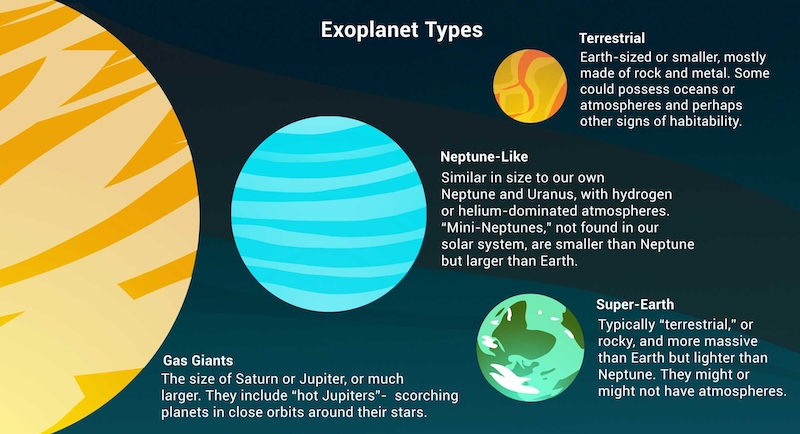Like the planets in our solar system, exoplanets come in various sizes and types. But some apparently don’t stay the same size. In fact, some exoplanets appear to be able to shrink. How is that possible? Scientists at NASA, Caltech and other institutions said on November 15, 2023, that they might have an answer. They said some sub-Neptune exoplanets – gaseous worlds with smaller radii than our solar system’s planet Neptune, but larger than Neptune in mass and so more dense – have cores that are pushing away their atmospheres from the inside out. So these gaseous planets are losing their atmospheres. And thus they’re shrinking in size.
The existence of shrinking sub-Neptunes might explain the unusual size gap between them and super-Earths, which are more massive than Earth, but less massive than Neptune.
That is, some sub-Neptunes simply become super-Earths.
The researchers published their peer-reviewed findings in The Astronomical Journal on November 15, 2023.
A size gap in exoplanets
After discovering more and more exoplanets over the past few decades, astronomers have noticed something odd. Both rocky super-Earths and larger gaseous sub-Neptunes are fairly common. But there is a distinct lack of exoplanets between those two sizes. This size gap – of planets 1.5 to two times the size of Earth – has puzzled astronomers. What is causing it?
The 2024 lunar calendars are here! Best Christmas gifts in the universe! Check ’em out here.
As lead author Jessie Christiansen at Caltech in Pasadena, California, explained:
Scientists have now confirmed the detection of over 5,000 exoplanets, but there are fewer planets than expected with a diameter between 1.5 and two times that of Earth. Exoplanet scientists have enough data now to say that this gap is not a fluke. There’s something going on that impedes planets from reaching and/or staying at this size.
Shrinking exoplanets
The new findings suggest that shrinking exoplanets can explain the mysterious size gap. Some larger sub-Neptune planets shrink to become super-Earths, leaving no intermediate sized planets. Hence the gap in sizes. But how is that happening?
The researchers said that if a sub-Neptune doesn’t have enough mass, it could start to lose some of its atmosphere. This is due to not enough gravitational force to hold onto all of the atmosphere. By losing some or much of their outer atmospheres, these planets would “shrink” in overall size.
That can explain the size differences, but exactly how are these planets’ atmospheres being decimated? There have been two main theories posited to date: core-powered mass loss and photoevaporation.
In core-powered mass loss, the planet’s hot core releases radiation. That radiation “pushes out” the atmosphere from underneath over time. Photoevaporation is kind of the opposite. Radiation from the planet’s host star blows away the outer atmosphere. Christiansen said that:
… the high-energy radiation from the star is acting like a hair dryer on an ice cube.
There’s another difference between the two scenarios. Scientists think that photoevaporation occurs early in the planet’s history, within the first 100 million years. Core-powered mass loss, however, doesn’t happen until about a billion years later. Both can lead to a loss of atmosphere. Christiansen said:
If you don’t have enough mass, you can’t hold on, and you lose your atmosphere and shrink down.

Star clusters provide clues to shrinking exoplanets
Either process could explain a lost atmosphere. So, how did the researchers determine which of the two possibilities is more likely? They used data from the Kepler Space Telescope‘s extended mission, called K2. They focused on two star clusters specifically, Praesepe (also known as the Beehive cluster or M44) and the Hyades. Both are known to contain many sub-Neptunes.
The ages of the stars in these clusters is of particular importance. The stars are between 600 million and 800 million years old. While still relatively young, their sub-Neptunes – about the same age – are old enough that photoevaporation would have already occurred several hundred million years ago. But they are not old enough yet for core-powered mass loss.
With this in mind, the researchers reasoned that if there were still many full-sized sub-Neptunes in these clusters, then they couldn’t have experienced photo evaporation. And indeed, they found that nearly all the stars in the clusters have a sub-Neptune or at least a candidate. They are still full-sized, meaning they have held onto their atmospheres.
Core-powered mass loss most likely explanation
Meanwhile, in some older star clusters, only about 25% of those stars have sub-Neptunes. This fits with the scenario that core-powered mass loss would have occurred by that point. That would result in fewer sub-Neptunes and more super-Earths. If photo evaporation had happened in Praesepe and the Hyades, then those planets should have lost much of their atmospheres. But they didn’t.
The results leave core-powered mass loss as the most likely explanation for the shrinking planets. But, as the press release said, the research is far from complete, so:
… it is possible that the current understanding of photoevaporation and/or core-powered mass loss could evolve. The findings will likely be put to the test by future studies before anyone can declare the mystery of this planetary gap solved once and for all.
Bottom line: Scientists say they may have solved the mystery of shrinking exoplanets. Radiation from the cores of less massive sub-Neptunes pushes away their atmospheres.
Read more about the differences between super-Earths, mini-Neptunes and sub-Neptunes.
Source: Scaling K2. VII. Evidence For a High Occurrence Rate of Hot Sub-Neptunes at Intermediate Ages
Via NASA
Read more: How shrinking planets might explain missing planets
Read more: Super-Earth and mini-Neptune in synchronized dance